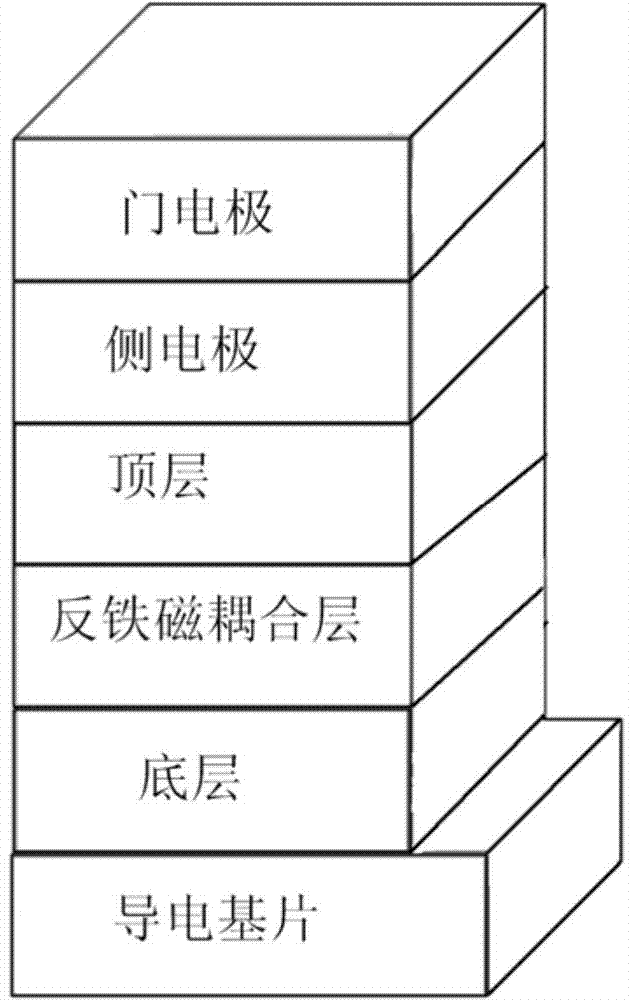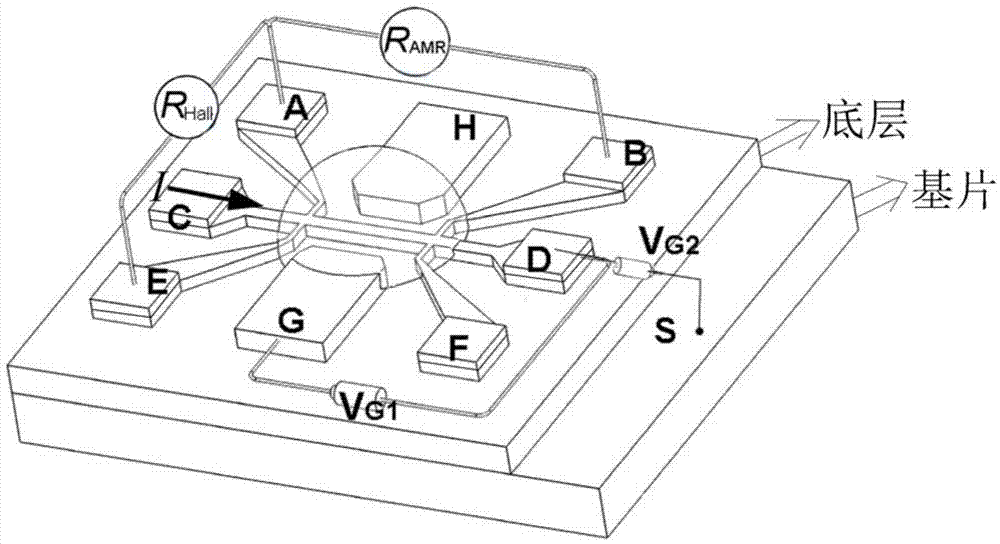Electric field regulating antiferromagnetic base Hall device and preparation method thereof
A Hall device and electric field regulation technology, applied in the field of electronic devices, can solve the problems of difficult control, limit the practical process, etc., achieve the effect of clear interface, insensitive to external magnetic field and thermal disturbance, and reduce interference
- Summary
- Abstract
- Description
- Claims
- Application Information
AI Technical Summary
Problems solved by technology
Method used
Image
Examples
Embodiment 1
[0049] Embodiment 1, preparation Y 3 Fe 5 o 12 / IrMn / HfO 2 / Hall device with ionic liquid structure
[0050] Preparation of Hall device:
[0051] (1) Doping SrTiO in Nb 3 A 500 μm wide side is reserved on the edge of the substrate, and 50 nm of yttrium iron garnet (Yttrium iron garnet (Y 3 Fe 5 o 12 ), marked S on the side, for test wiring. (2) In the bottom layer Y 3 Fe 5 o 12 Coat the photoresist of type AZ5214E, then use ultraviolet exposure to make the pattern of the Hall device, and sequentially deposit a 5nm antiferromagnetic coupling layer IrMn and a 2nm top layer of hafnium dioxide (HfO 2 ), and then use acetone to remove the glue, and use a lift-off process to obtain a part of the Hall device. The area of the square where the top layer is located is 2000×2000 μm 2 , the area of the overlapped part of the center of the two cross-shaped structures in the middle is 40×30 μm 2 . (3) if figure 2 As shown, 20nm Ti and 80nm Au were deposited by electron...
Embodiment 2
[0054] Embodiment 2, preparation BiFeO 3 / FeRh / HfO 2 / Hall device with ionic liquid structure
[0055] Preparation of Hall device:
[0056] (1) in SrRuO 3 A 500μm wide side is left on the side of the substrate, and 100nm BiFeO is deposited by masking 3 , marked S on the side, for test wiring. (2) On the underlying BiFeO 3 Coat the photoresist of model AZ5214E, then use ultraviolet exposure to make the pattern of Hall device, and deposit 20nm antiferromagnetic coupling layer FeRh and 2nm top layer HfO in sequence 2 , and then use acetone to remove the glue, and use a lift-off process to obtain a part of the Hall device. The area of the square where the top layer is located is 1000×1000 μm 2 , the area of the overlapped part of the center of the two cross-shaped structures in the middle is 20×15 μm 2 . (3) The eight square electrodes of A, B, C, D, E, F, G, and H are plated with a Ti layer of 20nm and an Au layer of 80nm by electron beam evaporation by ultraviolet ...
Embodiment 3
[0059] Embodiment 3, PZT / [Co / Pt] / IrMn / HfO 2 / Hall device with ionic liquid structure
[0060] Preparation of Hall device:
[0061] (1) in SrRuO 3 A side with a width of 500 μm is reserved on the side of the substrate, and 50 nm of PZT is deposited by using a mask, and the side is marked as S for testing wiring. (2) Coat the photoresist type AZ5214E on the underlying PZT, then use ultraviolet exposure to make the pattern of the Hall device, and deposit the antiferromagnetic coupling layer [Co / Pt] in sequence 5 / IrMn and 2nm top HfO 2 , where the thickness of Co is 0.6nm, the thickness of Pt is 1nm, and the thickness of IrMn is 3nm. Afterwards, acetone was used to remove the glue, and a part of the Hall device was obtained by a lift-off process. The area of the square where the top layer is located is 2000×2000 μm 2 , the area of the overlapped part of the center of the two cross-shaped structures in the middle is 40×30 μm 2 . (3) The eight square electrodes of A,...
PUM
 Login to View More
Login to View More Abstract
Description
Claims
Application Information
 Login to View More
Login to View More - R&D
- Intellectual Property
- Life Sciences
- Materials
- Tech Scout
- Unparalleled Data Quality
- Higher Quality Content
- 60% Fewer Hallucinations
Browse by: Latest US Patents, China's latest patents, Technical Efficacy Thesaurus, Application Domain, Technology Topic, Popular Technical Reports.
© 2025 PatSnap. All rights reserved.Legal|Privacy policy|Modern Slavery Act Transparency Statement|Sitemap|About US| Contact US: help@patsnap.com


